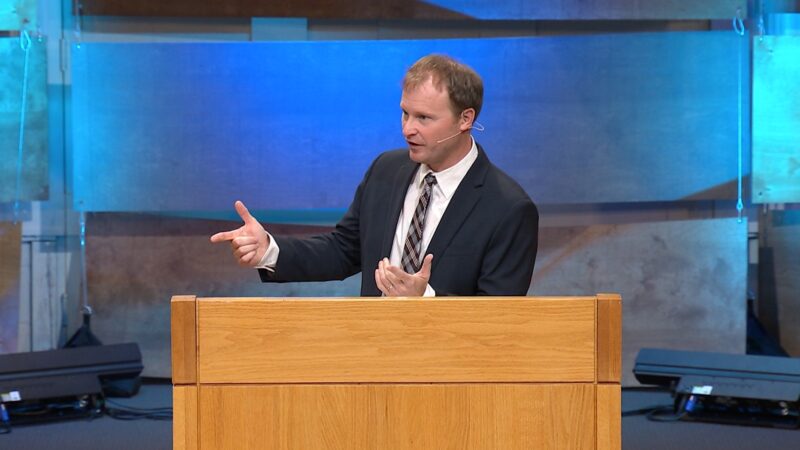http://rss.desiringgod.org/link/10732/16090912/end-of-the-global-south

ABSTRACT: In the early 1980s, missionary and researcher David Barrett published the World Christian Encyclopedia, a massive survey of global Christianity and missions. Since then, the work of Barrett and others has shaped the church’s approach to missions in profound ways, not least by focusing attention on the world’s remaining unreached peoples. Now, new generations of researchers are tracing the gospel’s spread through the Global South and beyond, showing that today’s church is more diverse than many have imagined — and helping today’s Christians participate more strategically in the gospel’s advance.
Evangelicals are serious about missions. To crib a quote from the American historian Douglas Sweeney, “Evangelicals care about nothing more than evangelizing the world.”1 Sweeney may be speaking in hyperbole, but not by much. We are passionate about doing and well-known for our activism. This is an evangelical strength. What evangelicals, as a group, have not always taken seriously is the life of the mind. As Mark Noll wrote in his epistle of a wounded lover, “The scandal of the evangelical mind is that there is not much of an evangelical mind.”2 We have not been as passionate about thinking and are not as well-known for our erudition. This has been an evangelical weakness.3
American evangelical missions during the twentieth century often failed to combine zeal with knowledge.4 In a recent lecture on the history of missiology, Brian Stanley observed that “there is always a tendency, particularly in Christian missions, for the field to divide between the doers and the thinkers.” He rightly referred to the problem as a “fatal separation,” and one that may be more pronounced in missions than in any other area of Christian ministry. Stanley, a highly respected intellectual, is also an evangelical who is very much for missionary activity. As he put it in the same address, “The challenge is to enable practitioners to be less afraid of deep research and reflection, but to conversely challenge the thinkers with the continuing imperative of what the church is actually called to do.”5
There have been times in our recent past when the thinkers and the doers actually did get together. This essay introduces readers to the work of David Barrett and a remarkable story of success that has brought about significant changes in the way evangelicals carry out the Great Commission. A discussion about Christianity in the Global South will follow, interacting with Philip Jenkins’s recent comments about what he calls “the end of the Global South.” What does he mean — and what are the possible implications for the church and its mission?
‘Miracle from Nairobi’
In 1982, Oxford University Press published the 1,010-page World Christian Encyclopedia (WCE).6 It was edited by David Barrett (1927–2011), who served as a missionary with the Church Missionary Society from 1957 to 1985. Barrett was a British evangelical who had prepared for the Anglican priesthood at Ridley Hall, Cambridge. He was mentored by Stephen C. Neill (1900–1984), a missionary to India who later became an academic at the University of Cambridge.7 After finishing his studies at Cambridge (BA, MA), Barrett served as a missionary in Kenya (then British Kenya) before continuing his studies at Union Theological Seminary (STM) and Columbia University (PhD). Barrett the missionary, like his mentor, became Barrett the academic.
After finishing his doctorate at Columbia, where he did his work on African Independent Churches, Barrett returned to East Africa for an ambitious research project. Using Nairobi as his base, between 1968 and 1981 Barrett traveled to nearly “every country in the world” (he listed 212 countries) to harvest statistics on Christianity and missionary activity throughout the world. He worked with a team of 21 editors and more than five hundred consultants, one of whom was Patrick Johnstone, the missionary-researcher and author of Operation World.8 The project was slated to take three years but was extended to twelve, because Barrett and the entire editorial team “had seriously underestimated the size and complexity of the Christian world.”9 Barrett’s massive survey showed that the vast majority of Christians lived in the “so-called Third World,” and that there were “Christian churches in every inhabited country on earth.”10 Time magazine hailed his work the “Miracle from Nairobi!”11
As a well-trained academic, Barrett used a widely accepted conceptual framework from the study of economic geography. His data was organized around what is still known as the Brandt Line, which divided the globe between the economically developed regions of the world in the Global North and those classified as economically underdeveloped in the Global South. The term Third World was then a shorthand reference to those nations with the least-developed economies, though in the 1980s this term was gradually replaced with the more congenial-sounding Global South. The latter was a reference to most (not all) of the countries of Africa, Asia, Latin America (including the Caribbean), and Oceania. The term Global North was used for the bloc of nations with developed economies that are concentrated in North America and Europe. This nomenclature is still widely used in the discipline of global studies and informs important decisions made by governments, NGOs, and intergovernmental agencies (such as the United Nations and the World Bank). The taxonomy still holds, though in recent years, with the rapid growth of some developing economies, the lines have begun to blur.12
Seeing the Unreached
One of the more fascinating applications of Barrett’s work was related to how evangelicals made decisions about where to assign missionaries. His data on missionary allocation showed that the Western church was continuing to send nearly all of its missionaries to parts of the world where Christianity had already taken root. A classic case is Kenya, where Barrett had lived since the 1950s, and had returned again and again for research. In 1900, Christians made up less than 1 percent of the population of what was then British East Africa, though by the year 2000 the percentage had increased to an estimated 77 percent.13 Even though Kenya had been largely Christianized, it remained (and remains) a popular destination for the allocation of evangelical missionary personnel. Many parts of Africa and most of Central and South America also fell into this category. Western mission agencies, Barrett’s research showed, were continuing to send people to places where foundations had already been laid, even to countries in the Global South that were overwhelmingly Christian. Many churches seemed to hold the assumption that effective missionary strategy simply meant acquiring a passport and sending people anywhere they “felt led” to go outside of the United States. This assumption needed to be completely reassessed.
Barrett’s work encouraged evangelicals to think about what they were doing. Soon after Oxford published Barrett’s miracle from Nairobi, the Foreign Mission Board (FMB) of the Southern Baptist Convention (SBC) hired Barrett to work as a consultant. The FMB (now the International Mission Board) was one of the largest and most influential mission agencies in the world. Using Barrett’s research, the FMB determined that there needed to be a greater focus on what is commonly called “unreached people groups.” Donald McGavran (1897–1990), a WCE consultant, and Ralph Winter (1924–2009), an early advisor, had already begun popularizing the language of “unreached” or “unengaged” people groups in the 1970s, though Barrett’s research was instrumental in its usage.14 The FMB set up a think tank called the Global Strategy Group to reappraise its allocation of missionary personnel. The SBC was so persuaded by the need to act on this research that, in an unprecedented display of interagency cooperation, it invited 36 other missions organizations to give serious consideration to Barrett’s proposals.15 The changes brought about by Barrett’s research over the next few decades have been called “seismic and enduring.”16 When Barrett died in 2011, the global strategist for the SBC wrote, “When David Barrett came to the Foreign Mission Board as a consultant in 1985, less than 3 percent of our mission force was deployed to [unreached, unengaged souls]. Today, as a result of Barrett’s prophetic push, more than 80 percent of the people groups our missionaries serve among are unreached.”17
“The willingness of evangelicals to think about what they were doing has led to greater evangelical faithfulness.”
John Piper made an even wider audience aware of Barrett’s work in his book Let the Nations Be Glad! The Supremacy of God in Missions, first published thirty years ago. Piper cited David Barrett, Patrick Johnstone, and Ralph Winter throughout, taking evangelicals to task for what Winter had called “people blindness.” His plea combined rigorous exegetical work with impressive missiological reflection. He corrected misunderstandings of the English word nation and urged evangelicals to place greater emphasis on declaring the marvelous works of God among all ethnic groups.18 Piper’s lively and learned contribution to missiology, which has sold more than 300,000 copies since its first printing, has probably influenced evangelical thinking on missions more than any single work that has been published over the last thirty years.19 The willingness of evangelicals to think about what they were doing has led to greater evangelical faithfulness to the missio Dei.
End of the ‘Global South’?
I recently had a conversation with Philip Jenkins about his suggestion that we might now be entering a new era, one that he calls “the end of the Global South and, consequently, of global/world Christianity.”20 Jenkins’s 2002 book The Next Christendom: The Coming of Global Christianity helped focus the attention of literate laypersons and learned academics on the rapid growth of Christianity in Africa, Asia, and Latin America. As he put it then, “The era of Western Christianity has passed within our lifetimes, and the day of Southern Christianity is dawning.”21 Jenkins helped popularize what Barrett and others had been working on since the late 1960s. In light of Jenkins’s usage of the expression Global-South Christianity and his insightful work on the “coming of global Christianity,” it is reasonable to ask what he means by these comments. Is Global-South Christianity no longer a helpful category? Has global/world Christianity already come and gone?
Looking back now over the last two decades, Jenkins has observed that there has been “real progress in the popular awareness of global affairs among Christians.” He notes that “in recent years, the situation has changed utterly. Publishers have turned out countless volumes in world or global Christianity, a topic that is now very well covered in seminaries and religious departments.”22 The remarkable literary achievements of academics like Andrew Walls, Lamin Sanneh, Dana Robert, Brian Stanley, Kirsteen Kim, Kwame Bediako, Jehu Hanciles, Mercy Oduyoye, Todd Johnson, Dyron Daughrity, Scott Sunquist, Paul Hiebert, Gina Zurlo, and Wilbert Shenk (to mention only a few names!) are now enlarging the story of Christianity.23 A younger generation of academics is also standing on the shoulders of giants and writing fresh histories of Christianity with sweeping coverage of nearly every country in the world. The field of global/world Christianity now comprises historians, theologians, sociologists, anthropologists, linguists, and missiologists, many of them clustered around the Yale-Edinburgh Conference, co-founded in 1992 by Andrew Walls (1928–2021) and Lamin Sanneh (1942–2019).24 These scholars are interested in the broader theme of global/world Christianity, but individuals also specialize in particular regions (e.g., continents, subcontinents) and countries, and also focus on subjects like transnational movements (e.g., evangelicalism, Anglicanism, Pentecostalism) as well as specific topics (e.g., men and women, politics, migration, mission).
Generous samples of their scholarship are found in print and online academic journals published by major research universities in places like Boston, Cambridge, Edinburgh, and Princeton. Lengthy bibliographic entries can be accessed in works like the Edinburgh Companions to Global Christianity, the World Christian Encyclopedia (bibliographies are listed under every country) and the new nine-volume Cambridge History of Christianity. There is now voluminous coverage of Christianity in every historical period, covering nearly every single country of the world. Gina Zurlo’s recent work Global Christianity: A Guide to the World’s Largest Religion from Afghanistan to Zimbabwe is an effort to make some of this scholarly work more accessible for a general readership.25 Hundreds of highly motivated academics, a surprising number of whom are evangelicals, are shedding new light on the church’s story.
Global from the Beginning
This enormous output of research on the history of Christianity from the first century to the present is now showing that the church is more diverse than we have ever imagined. When the Spirit of God came blowing in at Pentecost, the gospel was translated into the languages of Africa, Arabia, Asia, and Europe, spilling out from Jerusalem to the ends of the earth. Sometime around AD 60, the apostle Paul could already say that the gospel is “bearing fruit and increasing” throughout “the whole world” (Colossians 1:6). Christianity has been a worldwide, polycentric movement from its inception, and contrary to popular misconceptions, Rome has never been the sole seat of ecclesiastical authority. In point of fact, Christianity was adopted as the official religion of Armenia and Georgia in Asia and Aksum (Ethiopia) in Africa before it became the state religion of Rome in the West. In the ancient church (ca. 100–450), networks of churches were clustered around places like Jerusalem, Antioch, and Constantinople in Asia; Alexandria in Africa; and Rome in the West, with multiple centers of influence all confessing a near-identical creed. For a brief period in the early Middle Ages, these five regions formed a pentarchy (five coequal spheres), but even prior to the usage of this term in the sixth century, new centers had already formed further afield in Asia as far as India and China, across Africa as far south as Sudan, and to the farthest reaches of Western and Northern Europe. The work of historians is helping us see more than ever before that Christianity has been a diverse, global religion for two thousand years.
“Christianity has been a worldwide, polycentric movement from its inception.”
In our own day, the growing ethnic and geographic diversity of Christianity is pushing thinkers like Jenkins to challenge how we use expressions like the Global South and global/world Christianity. Jenkins believes that the classifications Global South and Global North are helpful ways of having conversations about macrolevel trends, but that they fail to do justice as descriptors of Christianity’s boundless diversity. With so much scholarly light having now been cast on Christianity in every country of the world, he wants to be careful about using the term Global South as though it were a religious monolith. He wants to avoid language that simply divides the church into halves. To be fair to my colleagues working in religious demography, they are not using the terms in this way, and Jenkins himself still uses Global-South Christianity in his writing. More controversially, the boundless diversity of Christianity has even led a few academics to adopt the expression “world Christianities” (plural) rather than global/world Christianity (singular), though this language is now being convincingly contested.26
A few examples will suffice to illustrate what Jenkins is talking about. Christianity has grown rapidly in Kenya, as well as in neighboring South Sudan, yet the church in both countries has been shaped by different narratives and disparate political and social realties. Nigeria is roughly divided between Christianity and Islam, creating unique conditions and challenges for the church within different regions of the same country. Christianity is growing in Northeast India as well as in the neighboring hermit-kingdom of Bhutan, but in decidedly different ways, due in part to starkly different political and social contexts. Historians still write about Korean Christianity, though the churches of North Korea and South Korea are undeniably living out their faith in different political contexts. Christianity across Central America has common features, but you can see and feel the differences between the churches of Guatemala and neighboring Honduras — and both countries are distinct from Costa Rica, with its large expat community. Brazil provides one of the most interesting examples of Christian diversity, with evangelicals and Pentecostals now diffused in nearly every tradition, including Roman Catholicism, in a way that has now influenced national elections. These are but a few examples of contrast, and we haven’t even begun talking about the vast continental differences. As Jenkins has put it, “In demographic and cultural terms, the world is anything but flat.”27 Said another way, the Global South is not a country.
Drama of Unfolding Redemption
Scholars will continue their work (and their debates), but what is important to note here is that the academic study of Christianity’s past and present has been a source of tremendous wisdom for evangelical engagement in global missions. This should encourage Christians who have been suspicious of the life of the mind not to be afraid of careful reflection. The increased awareness in our own day of Christianity’s boundless diversity also has implications for missions — a topic that needs further exploration. One implication is clear: the opportunity has never been greater for the whole church to take the whole gospel to the whole world. What is needed is a shift in missional thinking, one that abandons an America-first mentality, and one that adopts a gospel-first mindset. To repackage a Pauline trope, the gospel did not originate with us, and we are not the only ones it has reached. The way of the future is in working together across cultures in cross-cultural missions for the glory of God.
“The opportunity has never been greater for the whole church to take the whole gospel to the whole world.”
What we are witnessing today through the work of globe-trotting researchers and travel-worn academics is the glorious drama of God’s unfolding worldwide redemption. The Spirit is blowing where he pleases, the kingdoms of the world are continuing to enter the kingdom of the Lord from the east and the west, the north and the south, and the nations are singing the praises of God. These stories are now being churned out by major academic presses as scholars have turned their attention to understanding the “surprising work of God” around the world. Christian academics have eyes to see the overarching work of redemptive history in their scholarship, even as they delight in the increasing diversity of the church “that no one [can] number, from every nation, from all tribes and peoples and languages” (Revelation 7:9). New research is helping us reimagine the Christian world and widening our gaze to apprehend more fully the glory of God, world without end. Amen.28



